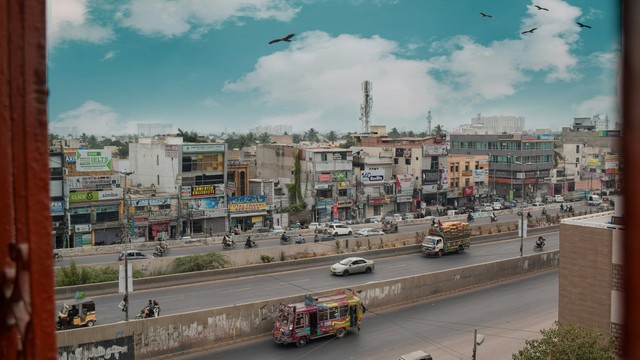Urban communities are devising their own solutions to build resilience
Community-led solutions to the challenges of climate change are creating more resilient city infrastructure, researchers have found.


Construction of new homes designed with community inputs in Gorakhpur, India (Photo: Copyright Nivedita Mani and team)
Increased flooding, heavy storms and extreme weather events pose a particular problem in cities, with the poorest and most vulnerable people often bearing the worst impacts. Weak infrastructure and services magnify the impacts of extreme events for vulnerable groups.
How can we improve services to these groups? Is there a way to enable communities to develop their own resilience to climate change? These were some of the questions addressed by researchers from across Asia funded by the Asian Cities Climate Change Resilience Network (ACCCRN) at a recent workshop in Bangkok.
Resilient cities are those able to face shocks and environmental challenges while at the same time addressing deficiencies in basic services. Residents of low-income urban communities are able to recognise and develop self-reliant services to build resilience to climate change, which then sets an example of appropriate and desired service provision for governments to follow. But what does this community-led planning look like on the ground?
Resilient infrastructure
One thing that is becoming increasingly clear is the importance of appropriate and resilient infrastructure. Two cases from the ACCCRN workshop demonstrated the vulnerability communities encounter when they depend on inappropriate and insufficient centralised services.
Fishermen in central Vietnam face particular challenges when the electricity goes out. Their catch cannot be refrigerated, and they are forced to pay for a car rental to take their product to distant markets.
The country's centralised energy system relies on coal, gas, and electricity, leaving it vulnerable to disruption and failure during extreme weather and flood events. This creates a dependence on a system that is prone to collapse, eroding the resilience of the communities that rely on it.
Disconnecting from government energy services to develop independent energy sources, such as micro-wind or biogas, can help to build resilience for vulnerable groups.
Vulnerable residents in Baguio in the Philippines struggle to access the already-poor water services available through centralised infrastructure, despite the area being known for its high rainfall. Homes considered 'serviced' only receive piped water three-to-four days per week, for four hours of the day, and a significant amount of water is mismanaged through leaks and illegal pipeline connections. Up to 50 per cent of the community lacks access to the service, leaving many to rely on private providers for potable water.
Communities facing similar water challenges elsewhere have successfully used rainwater collection tanks attached to individual family homes. This can allow families not only access to, but also control over, their water resources, improving resilience through self-reliance.
These examples demonstrate the importance of providing suitable and accessible infrastructure to vulnerable communities, and how enabling communities to access services independent of centralised infrastructures may be the best approach.
Building resilience through local planning and organisation
Of course, infrastructure alone is not enough to make urban populations more resilient. Involving communities in the development and design of new infrastructure also plays a critical role, as seen in two more ACCCRN projects.
In Gorakhpur, India, ward-level committees provide an opportunity for community participation in infrastructure design, while in the Philippines, People's Plans have been developed to facilitate community organisation around infrastructure planning.
Urban poor communities in Gorakhpur are all too familiar with the intense storms that blow through the city, and are now incorporating their locally developed solutions into formal designs for new housing in the region.
Residents frustrated with flooding and stagnant water in their homes called for new designs with a raised foundation, termed 'corbelling', which allows for excess water to flow beneath the structure. And, because families may choose to stay with their homes during floods, developers added concrete shelves just below the ceiling so that valuables and food could be safely stored during high waters.
Local knowledge has also introduced local material into resilient design and construction. Roofing made from terra cotta and bamboo is one example, where bamboo branches are lined up and sealed together using terra cotta, which dries to create an impermeable surface.
Informal settler families in Metro Manila, Philippines, often live in unsafe housing along river banks that are prone to flooding. Government efforts to relocate these groups end with many families returning to their original high-risk site to regain access to their livelihoods.
Under the People's Plan, a new initiative by the Philippine government, these informal settler communities have been enabled to design their own in-situ or near-city resettlement, providing inputs on things like building design, site layouts, and new site selection with assistance from planners and architects.
Together, these cases show how vulnerable communities can become more resilient to climate change when they themselves can demonstrate to governments the appropriate services and access they need. Service providers can learn from community initiatives and seek to implement this community driven change through formal infrastructure.
City Resilience Framework
These lessons from practice deepen our understanding and application of more abstract indicators, such as Arup's City Resilience Framework, which identifies seven qualities of resilient systems: reflective, robust, redundant, flexible, resourceful, inclusive, and integrated.
Vietnam's ability to evolve beyond centralised energy services, and Baguio City's awareness of their need for self-service, for example, show evidence of flexibility and resourcefulness.
Inclusivity can be seen in the engagement of communities in resilient housing design in Gorakhpur, India, and in the creation of a joint vision – the People's Plan – that contributes to city resilience in the Philippines. Also, both are reflective in their ability to evolve as they face new climate threats.
Resilient urban communities are supported by appropriate and accessible infrastructure. More importantly, resilient cities are constructed by strong citizen organisation and inclusion that can identify, coordinate, and implement these services.
Anne Tadgell (atadgell@gmail.com) is a visiting fellow in IIED's Human Settlements Group.



